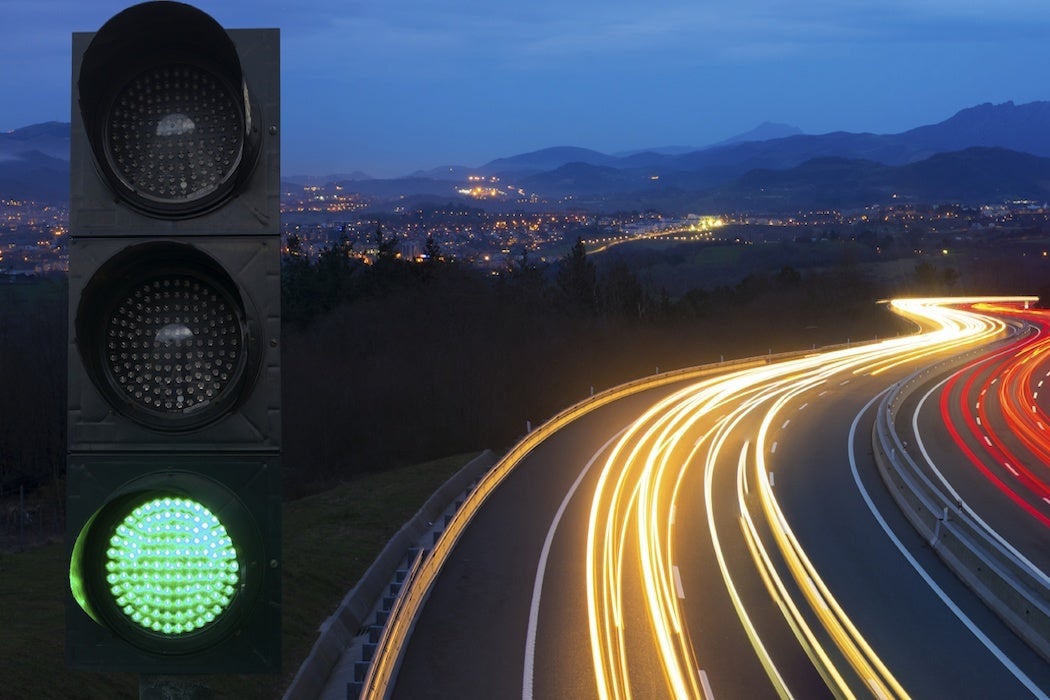As new drivers, many of us were taught to beware the stale green. If you’re approaching a traffic light that’s been green for a while, should you speed up to try to catch it? Should you slow down in anticipation of it changing? You don’t want to stop if you don’t have to, but you don’t want another car hitting your rear door as you try to sneak through that yellow light, either.
Apps like EnLighten, from Connected Signals, are trying to help drivers make this decision safely with a little help from vehicle-to-infrastructure (V2I) technology. The app can receive information from a city’s traffic infrastructure and predict when the signal will change. So, for example, if you’re waiting at a red light, the app collects such data as the current state of the light and the city’s timing plan to predict when it will turn green. Just before the change, the app chimes to let you know you should start paying attention to the road again.
The idea is to reduce accidents, reduce speeding to make the light, and save fuel, according to Connected Signals CEO Matt Ginsberg. For those worried about yet another distraction in the center console, Ginsberg said at a press conference that his team kept the app so simple that it would be “too boring to look at all the time.” It’s supposed to help drivers assess the information at the next intersection, not require constant attention.
The tricky part for any V2I technology is getting access to the infrastructure. Every city is different and must be approached individually, which makes rollout of these systems slow. Some cities don’t yet have the dedicated short-range communication (DSRC) transmitters affixed to traffic signals to send out the data the app needs.
Let There Be Lights
The smooth, safe flow of traffic is, of course, not a new issue. According to Science, modern traffic signals as we know and hate them were created in 1923. A team of 42 men convened in the spring of that year to decide, once and for all, the colors of the lights. Their goals were the same as V2I advocates’ goals today: to cut down on the loss of life each year due to traffic accidents and to “eliminate many of the existing irritations to motorists.” After nearly a century of red lights, it’s safe to say they achieved the first goal, but not the second.
Two years later—a mere blink of an eye in committee time—there were three colors agreed upon, the red, yellow, and green lights we still use today. Originally, the red light was to be used like a stop sign. Drivers were to “stop and to then proceed if conditions are favorable,” according to a Science notice published in 1925. Yellow meant drivers should exercise caution, and green meant it was all right to proceed.
These colors were not selected arbitrarily—this was the American Engineering Standards Committee, after all. During testing, red light was the easiest to distinguish from other colors at a distance and required the least light intensity. At 600 feet, the committee found that a red light could be seen at only 75 candlepower. Green could be identified at 250 candlepower, and yellow at 750.
It’s All in the Timing
In the early days of traffic signals, the idea was to get people to recognize and react, automatically and correctly, to the changing lights. Once drivers had mastered that, and the number of accidents at intersections dropped, engineers turned their scrutiny to the flow of traffic.
In 1960, the journal Operations Research published a study of how traffic flowed through a series of timed traffic signals. The study’s author, Professor G. F. Newell of Brown University, wanted to determine what the proper timing might be to minimize the average delay for cars moving through intersections. He found that it wasn’t enough to know how long cars waited at red lights; you also had to know how the cars behaved when the light turned green. The speed at which the cars take off in succession will affect the flow of traffic at the next light, and the next one, and the next one.
As anyone who’s tried to outsmart the timed lights along a stretch of urban street knows, it’s not as simple as finding the ideal speed and holding it steady to make every green light. That might work at 3 in the morning, when the street is empty except for your car, but it fails completely when other cars are in the mix. If you’re in the third car lined up at a red light, you can’t just mash the gas as soon as the light turns green. Your behavior at the light depends on the behavior of the two cars in front of you. And that affects whether you’ll make it to the next green light or get stopped again.
This is what Newell was hoping to eliminate, and what EnLighten is still working to solve 56 years later. Newell found that if a car arrives at a light just as it’s turning from red to green, it will have already slowed down nearly to a stop “and be delayed just as if the red period were a bit longer.”
If you drive slightly faster than the ideal speed to make every green light, you’ll be delayed a little bit at every light, which is annoying and not without effects on traffic flow. If you drive a little slower than the ideal, though, Newell found that you’ll soon be further and further out of phase with the timing of the green lights, and you’ll start hitting red lights every time. His best recommendation was to set the lights so that “very few cars are traveling slower than the ideal speed.”
Whatever Gets You Through the Light
Today, city traffic lights are timed, though few drivers would agree that their timing is ideal. EnLighten isn’t alone in trying to lessen the annoyance and danger of red lights; cities themselves are becoming smarter in anticipation of connected cars and infrastructure. The Internet of things doesn’t include only thermostats and LED lightbulbs—it includes stop signs, speed limit signs, and cars.
As transmitters become smaller, cheaper, and more widespread, our vehicles will be able to pick up on the signals and translate them into actionable information. If a light is about to turn red but the driver isn’t slowing down, the car can interpret that data and gently activate the brakes to avoid a fender bender. Or, as with EnLighten, a chime can sound to remind you to stop scrolling through satellite radio stations and start driving when the light turns green.
In the near future, this is the technology that will enable vehicles to become autonomous. “It is of paramount importance,” the engineering committee wrote, “that the use or significance of all these signals become so familiar that they will produce an unconscious but correct and effective reaction, as it is doubt in the correctness of signal interpretation that leads to uncertainty in motions and to accidents.” Our cars will have to learn to obey traffic lights the same way our great-grandparents first did a hundred years ago.







